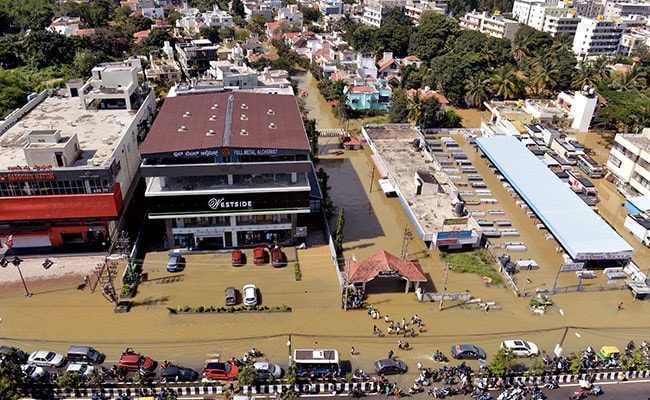
What caused Bengaluru floods and what remedies should it take? Expert talks

Once known as the lake city, it has now become a flooded city.
India’s silicon city has recently grabbed the eyeballs of the world for all the wrong reasons. A day of heavy rain and almost 85 regions and around 2,500 houses were overrun by water, more than 25,000 vehicles were damaged and around 50 apartments are still standing in a pool!
Accusations and justifications are being traded indiscriminatingly since Bengaluru received around 135 mm of rainfall on August 31.
The irony is that the advice given on urban planning by one of India’s top research organisations which is located in the city, the Indian Institute of Science (IISc), has fallen on deaf ears of concerned government bodies and builders.
Also read: Bengaluru: IT firms, startups ask staff to WFH amid rain, floods
Dr TV Ramachandra, who heads the IISc’s Centre for Ecological Sciences, and his team have conducted several studies which explain why Bengaluru is repeatedly facing floods and the mistakes made during the development of the city. The studies have suggested several measures on how to save and rejuvenate the lakes of Bengaluru and improve urban planning, etc. However, none seem to have heeded the advice, which has resulted in recent floods in the city.

Losing the lakes
Bengaluru was once called the ‘Land of Lakes’ as during the early 19th century. The then rulers created interconnected water bodies to meet the drinking water and irrigation requirements. By one estimate, there were 1,452 water bodies in the current spatial extent (741 sq km) of Bengaluru. Today, just 193 lakes are left.
Post-Independence, following industrialisation and growth in technology, the city acquired the moniker ‘Silicon Valley’, providing huge job opportunities. However, the city saw unplanned expansion and unrealistic and irresponsible urbanisation, Dr TVR’s research team pointed out.
Several public sector industries were set up between 1940 and 1970, transforming the city into a science and technology centre. By 1961, Bengaluru (then Bangalore) had become the 6th largest city in India, with a population of over 12 lakh. Between 1971 and 1981, Bengaluru’s growth rate was 76 per cent, the fastest in Asia. By 1988, the city had emerged as India’s software capital. Consequently, the 1990s saw a construction boom fuelled by Bangalore’s growing reputation as ‘India’s Silicon Valley’.
During this construction boom, illegal land conversion took place on a large scale. Today many of the 193 remaining lakes are being encroached upon, as are the raja kaluves (stormwater drains), IISc has cautioned.
Lack of accountability
Dr TV Ramachandra, while speaking to The Federal, said the major reason for the present situation is weak governance. “We have fragmented governance with too many para-state agencies. That’s why we are unable to fix accountability on any bureaucrat. Lack of transparency is also taken advantage of by land and water mafias. This process is called Rapid Unplanned Urbanisation,” he said.
Bengaluru, he said, had an interconnected lake system taking advantage of the undulating topography of the city. Water from one lake used to go to another lake to meet the irrigation and drinking water requirements. As a result, there was no scarcity of water. Also, as the water was flowing, there was no pollution, he explained.
In the 1970s, Ramachandra pointed out, we had 68 per cent green cover while today 85 per cent of the city is concretised. Too many faying surfaces – faces of two similar or dissimilar materials placed in tight contact to form a joint — are the route case of all problems. Faying surfaces stop any water from percolating into the ground, he said. As a result, around 80 per cent of water flows as overland flow. A large amount of water overland resulted in a flood, Ramachandra explained. White-topping of roads also adds to the problem.
Unplanned urbanisation in Bengaluru has led to a 1055 per cent increase in the concrete area. There was 75 per cent of water bodies and 88 per cent of green cover in Bengaluru four-and-a-half decades ago. Bengaluru today has just 14,78,000 trees. The resident population is 95 lakhs, meaning there is only one tree for every seven persons.
This ratio should be in reverse, according to Ramachandra. “We breathe out carbon dioxide to the extent of 540 to 980 gram per person per day. Every human being thus needs 7 or 8 trees,” he said. “Good vegetation also means that a large amount of water goes to the underlying area. That’s why there were no floods years ago,” he added.
Politician-builder nexus
The government is helping the builders in the region by narrowing down the drains (raja kaluve). Earlier, the drains were 45 metre in width and 80 metre in length. Now the government agencies have reduced it to 18 .5 metres and 20 metres, respectively. This is one of the main reasons for flooding in Koramangala and Bellanduru regions of the city.
“The Smart City is a bogus programme. It’s only to provide gadgets and all. It has not improved the amenities and infrastructure. White-topping is one such example. Normally, growth in cities abroad depends on infrastructure, availability of drinking water, etc. But in Bengaluru, they allow buildings to come up and then they cry for water. Road widening is also done later. We don’t have any vision,” Ramachandra said.
The solution
“We need to rejuvenate the lakes. Instead of making money in Mekedatu, we should use it to rejuvenate the lakes. Now Bengaluru has 193 lakes. Rainfall is 700 to 850 mm per year. That means 15 tmc of water on an average rainfall per year. The city requires 18 tmc of water and 70 per cent of water is available in the form of rain. The best option is to harvest rainwater,” Ramachandra said adding, “We should do wastewater treatment and not allow the industry to pollute the lakes with their heavy metal affluents.”
“If we waste 18 tmc of water, we also generate 18 tmc of wastewater. If we treat it, we will get 16 tmc of water. If we do rain harvesting and water treatment, we will get 31 tmc of water per year,” he pointed out.
Also read: Bengaluru continues its battle against floods, woman falls to death
Ramachandra stresses that unplanned urbanisation has to stop and Bengaluru needs to be decongested to solve the problem of flooding. Apart from this, interconnectivity between lakes needs to be re-established, and the Constructions and Demolition rules 2016, need to be implemented strictly. “The CM should think twice before releasing Rs 1,500 crore for remodelling of drains. It’s nothing but concretising and narrowing the drains. So, there will be no infiltration of water,” Ramachandra warns.

